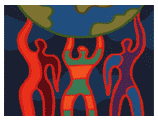
Training Field Staff to Take Photos
for Nonprofit, NGO & Government Initiatives

This presentation/training touches on both the kinds of photos needed and how to take photos in a culturally-sensitive manner.
This presentation is focused on a specific program and a
specific country (Afghanistan), but in 2022, I started working for
a small affiliate of Habitat for Humanity serving a rural area of
Oregon, and I was stunned at how much I faced exactly the same
challenges in staff taking photos in the field (of home building
activities, of partner families engaged in home building
activities, of home repairs for vulnerable homeowners and of the
homeowners themselves, etc.). And I will never forget in Oregon,
getting a photo of a pile of gravel from a field worker, meant to
represent an accomplishment at a work site, and thinking back to
an Afghan field engineer back in 2007 who brought be pretty much
the same photo to show accomplishments at an MMRD-funded work
site.
If you adapt this presentation for your own use, be sure that, when importing your own photos, that you make the photos have less dpi. You do this (in MS Powerpoint; not sure about OpenOffice or NeoOffice, but I'm sure it's similar) by:
Download here. It's 639 KB.
The result of this kind of training with staff? See the initiative's Flickr site; most of these photos were taken by various staff members, including Afghans, NOT by me .
Also see Building Staff
Capacities to Communicate and to Present, which
describes various activities undertaken to improve the
communication capacities of Afghan government staff, and links to
various slide presentations and materials used for this endeavor.
Tips for staying in
contact with remote staff in developing countries / conflict
zones
Many factors stand in the way of trying to stay in contact with
field staff at projects in rural or conflicted areas in developing
countries. I review all of the various challenges faced by people
in a main office in getting data from field staff working in
humanitarian / development / aid initiatives, and how to address
those challenges.
 my home page
my home page my
consulting services & my workshops
& presentations
my
consulting services & my workshops
& presentations my
credentials & expertise
my
credentials & expertise Affirmation
that this is web site is created & managed by a human
Affirmation
that this is web site is created & managed by a human
 My book: The
Last Virtual
Volunteering Guidebook
My book: The
Last Virtual
Volunteering Guidebook contact me
or see my
schedule
contact me
or see my
schedule Free Resources: Community Outreach, With & Without Tech
Free Resources: Community Outreach, With & Without Tech Free Resources: Technology
Tips for Non-Techies
Free Resources: Technology
Tips for Non-Techies Free Resources:
Nonprofit, NGO & other mission-based management resources
Free Resources:
Nonprofit, NGO & other mission-based management resources Free Resources: Web
Development, Maintenance, Marketing for non-Web designers
Free Resources: Web
Development, Maintenance, Marketing for non-Web designers Free Resources: Corporate
philanthropy / social responsibility programs
Free Resources: Corporate
philanthropy / social responsibility programs Free Resources: For people
& groups that want to volunteer
Free Resources: For people
& groups that want to volunteer linking to
or from my web site
linking to
or from my web site The
Coyote Helps Foundation
The
Coyote Helps Foundation me on
social media (follow me, like me, put me in a circle,
subscribe to my newsletter)
me on
social media (follow me, like me, put me in a circle,
subscribe to my newsletter)To know when I have developed a new
resource related to the above subjects, found a great
resource by someone else, published
a
new
blog, uploaded a new
video,
or to when & where I'm training or presenting, use any
of the following social media apps to follow me on any of
these social media platforms:
Disclaimer: No guarantee of accuracy or suitability is made by the poster/distributor. This material is provided as is, with no expressed or implied warranty or liability.
See this web site's privacy policy.
Permission is granted to copy, present and/or distribute a limited amount of material from my web site without charge if the information is kept intact and without alteration, and is credited to:

Otherwise, please contact me for permission to reprint, present or distribute these materials (for instance, in a class or book or online event for which you intend to charge).
The art work and material on this site was created and is copyrighted 1996-2024